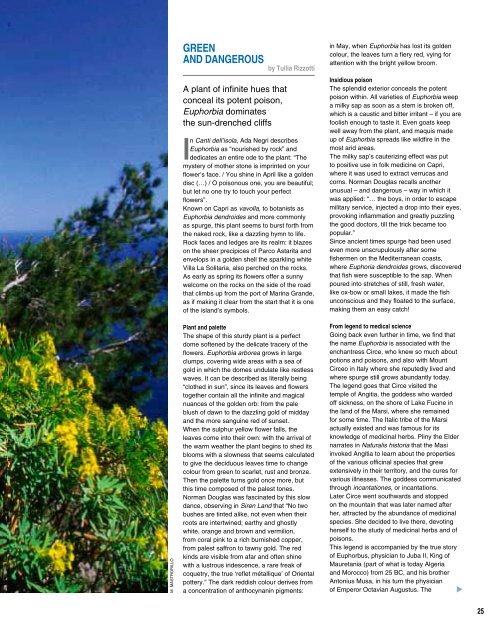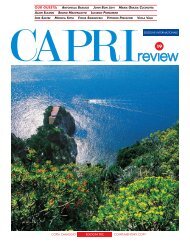Create successful ePaper yourself
Turn your PDF publications into a flip-book with our unique Google optimized e-Paper software.
M. MASTRORILLO<br />
GREEN<br />
AND DANGEROUS by Tullia Rizzotti<br />
A plant of infinite hues that<br />
conceal its potent poison,<br />
Euphorbia dominates<br />
the sun-drenched cliffs<br />
In Canti dell’isola, Ada Negri describes<br />
Euphorbia as “nourished by rock” and<br />
dedicates an entire ode to the plant: “The<br />
mystery of mother stone is imprinted on your<br />
flower’s face. / You shine in April like a golden<br />
disc (…) / O poisonous one, you are beautiful;<br />
but let no one try to touch your perfect<br />
flowers”.<br />
Known on <strong>Capri</strong> as vavolla, to botanists as<br />
Euphorbia dendroides and more commonly<br />
as spurge, this plant seems to burst forth from<br />
the naked rock, like a dazzling hymn to life.<br />
Rock faces and ledges are its realm: it blazes<br />
on the sheer precipices of Parco Astarita and<br />
envelops in a golden shell the sparkling white<br />
Villa La Solitaria, also perched on the rocks.<br />
As early as spring its flowers offer a sunny<br />
welcome on the rocks on the side of the road<br />
that climbs up from the port of Marina Grande,<br />
as if making it clear from the start that it is one<br />
of the island’s symbols.<br />
Plant and palette<br />
The shape of this sturdy plant is a perfect<br />
dome softened by the delicate tracery of the<br />
flowers. Euphorbia arborea grows in large<br />
clumps, covering wide areas with a sea of<br />
gold in which the domes undulate like restless<br />
waves. It can be described as literally being<br />
“clothed in sun”, since its leaves and flowers<br />
together contain all the infinite and magical<br />
nuances of the golden orb: from the pale<br />
blush of dawn to the dazzling gold of midday<br />
and the more sanguine red of sunset.<br />
When the sulphur yellow flower falls, the<br />
leaves come into their own: with the arrival of<br />
the warm weather the plant begins to shed its<br />
blooms with a slowness that seems calculated<br />
to give the deciduous leaves time to change<br />
colour from green to scarlet, rust and bronze.<br />
Then the palette turns gold once more, but<br />
this time composed of the palest tones.<br />
Norman Douglas was fascinated by this slow<br />
dance, observing in Siren Land that “No two<br />
bushes are tinted alike, not even when their<br />
roots are intertwined; earthy and ghostly<br />
white, orange and brown and vermilion,<br />
from coral pink to a rich burnished copper,<br />
from palest saffron to tawny gold. The red<br />
kinds are visible from afar and often shine<br />
with a lustrous iridescence, a rare freak of<br />
coquetry, the true ‘reflet métallique’ of Oriental<br />
pottery.” The dark reddish colour derives from<br />
a concentration of anthocynanin pigments:<br />
in May, when Euphorbia has lost its golden<br />
colour, the leaves turn a fiery red, vying for<br />
attention with the bright yellow broom.<br />
Insidious poison<br />
The splendid exterior conceals the potent<br />
poison within. All varieties of Euphorbia weep<br />
a milky sap as soon as a stem is broken off,<br />
which is a caustic and bitter irritant – if you are<br />
foolish enough to taste it. Even goats keep<br />
well away from the plant, and maquis made<br />
up of Euphorbia spreads like wildfire in the<br />
most arid areas.<br />
The milky sap’s cauterizing effect was put<br />
to positive use in folk medicine on <strong>Capri</strong>,<br />
where it was used to extract verrucas and<br />
corns. Norman Douglas recalls another<br />
unusual – and dangerous – way in which it<br />
was applied: “… the boys, in order to escape<br />
military service, injected a drop into their eyes,<br />
provoking inflammation and greatly puzzling<br />
the good doctors, till the trick became too<br />
popular.”<br />
Since ancient times spurge had been used<br />
even more unscrupulously after some<br />
fishermen on the Mediterranean coasts,<br />
where Euphoria dendroides grows, discovered<br />
that fish were susceptible to the sap. When<br />
poured into stretches of still, fresh water,<br />
like ox-bow or small lakes, it made the fish<br />
unconscious and they floated to the surface,<br />
making them an easy catch!<br />
From legend to medical science<br />
Going back even further in time, we find that<br />
the name Euphorbia is associated with the<br />
enchantress Circe, who knew so much about<br />
potions and poisons, and also with Mount<br />
Circeo in Italy where she reputedly lived and<br />
where spurge still grows abundantly today.<br />
The legend goes that Circe visited the<br />
temple of Angitia, the goddess who warded<br />
off sickness, on the shore of Lake Fucine in<br />
the land of the Marsi, where she remained<br />
for some time. The Italic tribe of the Marsi<br />
actually existed and was famous for its<br />
knowledge of medicinal herbs. Pliny the Elder<br />
narrates in Naturalis historia that the Masi<br />
invoked Angitia to learn about the properties<br />
of the various officinal species that grew<br />
extensively in their territory, and the cures for<br />
various illnesses. The goddess communicated<br />
through incantationes, or incantations.<br />
Later Circe went southwards and stopped<br />
on the mountain that was later named after<br />
her, attracted by the abundance of medicinal<br />
species. She decided to live there, devoting<br />
herself to the study of medicinal herbs and of<br />
poisons.<br />
This legend is accompanied by the true story<br />
of Euphorbus, physician to Juba II, King of<br />
Mauretania (part of what is today Algeria<br />
and Morocco) from 25 BC, and his brother<br />
Antonius Musa, in his turn the physician<br />
of Emperor Octavian Augustus. The<br />
<br />
25







